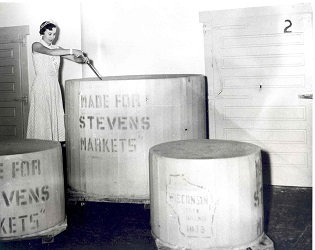From its wholesome and pastoral beginnings following World War II to today's high-tech age of instant communications via social and traditional media, the Alice in Dairyland program has grown and changed with the times.
In 1948, Alice was a beauty queen fresh out of high school. Today, she is professional public relations professional with at least four years of experience or education in agriculture, public relations, communications, or related fields. Beyond individual communication skills, the list of job requirements includes knowledge about Wisconsin's diverse agriculture and products, history, resources, and rural-urban issues. Alice is expected to work effectively with colleagues, the media, and the public. She develops her own educational materials, speeches, and presentations.
The early Alice traveled nationwide with a chaperone, logging 150,000 miles a year – most of it on airplanes – and making 1,000 appearances annually. Today's Alice spends much of her time driving Wisconsin's highway and byways, accompanied by her cellular phone and GPS. However, she continues to travel both nationally and internationally, and still logs tens of thousands of miles.
In that very first year, the program beat the bushes in rural Wisconsin looking for Alice contestants, and judges narrowed the field to 16 finalists based on photos alone. Today, the call for applicants goes across the state to colleges and universities and Wisconsin’s array of agribusinesses.
Early Alice contests drew hundreds of entries. Today, a rigorous set of professional skill requirements and qualifications narrows the field from many applicants to as many as six finalists.
The process of choosing Alice has changed substantially over the seven decades of the program. The selection criteria that first year was simply ‘beauty and health, general personality, and ability to present herself and her message before large groups.’ By the late 1950s, the selection process began in May and culminated in August. Four “Alice princesses” were named in June, and they spent the next two months in a constant job audition until Alice was named in August.
Today, Alice in Dairyland is a marketing professional by any and all standards. In the first round of the selection process, applications are evaluated on resumes, personal interviews, and communications ability. If she meets these criteria, she still has to impress a selection panel during the three-day finals where she is evaluated on public speaking, personal interviews, TV and radio interviews, and agribusiness tours.
Once hired, Alice garners over a million dollars worth of free airtime and print space for Wisconsin's food, fiber, and natural resources industry. In return, she earns a salary of $40,000 plus travel and health expenses, along with valuable professional experience and contacts.
Over the years, Alice in Dairyland has indeed grown to adapt to the changing face of agriculture and the contemporary world. Even so, she remains a unique custodian of Wisconsin's proud agricultural tradition and dynamic voice for agriculture's future – Serving as Wisconsin’s agricultural ambassador.
 A Sampling of Alice Historical Events
A Sampling of Alice Historical Events
1952: Beverly Ann Steffen rides in the Rose Bowl parade.
1954: Mary Ellen McCabe appears on the Today show with Dave Garraway.
1958: Barbara Haslow presents an aged cheddar cheese to Jack Bailey, Queen for a Day, before a viewing audience of 10 million.
1961: Carol Jean Anderson hosts a wine and cheese reception for national and international media following the Green Bay Packers win over the New York Giants in the NFL championship game.
1963: Marilyn Draeger promotes cheese in Hollywood with celebrities like Glen Ford, Connie Stevens and Billy Graham.
1966: Alice begins working in schools.
1969: Judith Schultz dances with Lawrence Welk on his program; Wisconsin Mink Breeders begin an annual gift of a mink coat to Alice.
1977: Delmar Lied, founder of Lied's Nursery in Sussex, starts the "Alice Garden" at Milwaukee Area Technical College, planting a tree every year on Arbor Day to honor the current Alice in Dairyland.
1978: Laura Jean Oldenberg joins rockstar Alice Cooper in a milking contest at a grand opening of a Madison record store.
1983: Barbara Ward presents Willie Nelson with a Something Special from Wisconsin (TM) t-shirt.
1984: Wisconsin Jewelers Association creates the Alice tiara, with gems native to Wisconsin: citrines and amethysts. The tiara is passed to the new Alice each year, replacing the rhinestone crown kept by each Alice in the past.
1991: Renea Troeller takes part in a trade mission to Japan to promote Wisconsin beef and Christmas trees.
1993: Angela Corbin is made governor for a day in Chiba Prefecture during a trade mission to Japan.
1995: Jolynne Nagel helps promote Wisconsin products on QVC, an at-home cable TV shopping network.
1996: Holly Meudt promotes Wisconsin cheese during the 1997 Super Bowl – won by the Green Bay Packers.
1997: Courtney Ott drives a farm tractor along Wisconsin roads to promote agricultural tourism.
2001: Sheri Hicken develops a Public Service Announcement video contest encouraging Wisconsin high schoolers to make a connection to agriculture.
2002: Angela Hemauer runs the Whistle Stop Marathon in Ashland to promote "Wisconsin Foods that Fuel."
2004: Wisconsin Milk Marketing Board becomes a partner of the Alice in Dairyland program, supporting marketing efforts for dairy and educational opportunities in schools.
2005: Wisconsin Corn Promotion Board becomes a partner of the Alice in Dairyland program, supplying an E85 vehicle for Alice's official use.
2006 & 2012: Nicole Reese and Rochelle Ripp throw out the first pitch at the WMMB's Dairy Day at Miller Park during a Milwaukee Brewers Game.
Through all these high profile and celebrity appearances, each Alice has upheld the high standards tasked to her in educating consumers of all backgrounds about one of the major driving forces of Wisconsin's economy – agriculture.